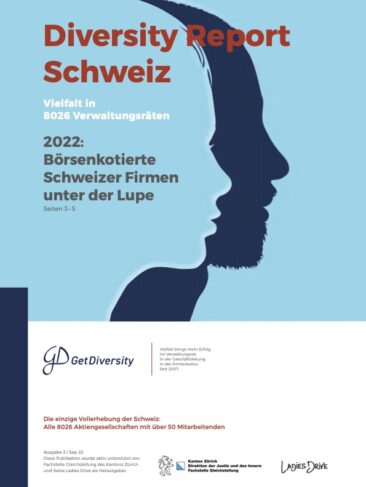Diversity in 8,026
executive boards
The Diversity Report Switzerland 2022 analyzes
231 listed companies
as well as 8,026 Swiss stock corporations with more than 50 employees.
Listed Swiss companies analyzed
Edition September 2022

Author: Esther-Mirjam de Boer

Diversity in 231 and 7'656 executive boards
The Diversity Report Switzerland 2021 analyzes
231 listed companies
as well as 7’656 Swiss stock corporations with more than 50 employees.
Listed Swiss companies analyzed
Edition June 2021
231 Swiss companies are listed on Swiss stock exchanges.
41 companies already comply with the gender benchmark on the board of directors.
11 companies already meet the new legal requirements for both benchmarks.
Non-executive boards:
from 19% to 30% in 5 years.
Executive boards:
12 women per year. For 10 years.
Dear Ladies and Gentlemen
The new company law came into force on 1 January 2021. After a transitional period, it requires listed companies domiciled in Switzerland to comply with gender benchmarks: 30% on boards of directors and 20% on executive boards. The current Diversity Report Switzerland measures the starting positon of the companies as of the end of February 2021.
In this way, the effect of the statutory gender benchmarks can be tracked in the coming years and compared to the development of companies that are not affected.
We wish you an exciting and informative reading.
Esther-Mirjam de Boer & Carla Jane Kaufmann
Partners and Managing Directors of GetDiversity
About GetDiversity
GetDiversity is the leading executive search firm and HR strategy consultancy for diversity & inclusion in Switzerland. We are the market leader in the placement of female board members and the second largest board search firm in Switzerland. Since 2007, we have been successfully advising companies and organisations that want to competently expand and embed diversity in their management teams at all levels in order to be attractive as an employer for 100% of the talent. Translated with www.DeepL.com/Translator (free version)
Diversity brings more success.
In the board of directors.
In the management.
In the corporate culture.
Dear Ladies and Gentlemen
I am aware that the name of this report is "Diversity Report".
And yet I would like to say: "Be brave and call activities for more diversity in your company «Inclusive Business Excellence»".
This can be certified according to the EFQM model and will be effective across all levels.
Sandra-Stella Triebl
Founder & EntrepreneurNetwork
Expert & Board Consultant
The new company law applied: a commentary by EXPERTsuisse on Art. 734f OR
How the regulations around the gender guidelines in company law are interpreted will ultimately be seen in auditing. Diversity Report spoke with Claudia Mattig and Dr. Marius Klauser from EXPERTsuisse, the expert association for auditing, taxes and fiduciary services, about what is on the horizon.
The entire interview can be read on page 5 of the report.
Article by Swiss Post
Language diversity - Building bridges and overcoming hurdles
Swiss Post employs people with a total of 76 different mother tongues. This linguistic diversity is particularly impressive at Switzerland's largest mail center: in Zurich-Mülligen. Here, the 1,100 employees have 38 different mother tongues. Around the clock, employees sort letters, advertising mail, newspapers and smaller parcels for the entire country. In the warehouses, employees speak languages ranging from Serbian to Portuguese, Thai and Finnish, and even Urdu. Linguistic and cultural diversity is very important to Roberto Cirillo, the CEO of Swiss Post, and he therefore wants to promote the use of French and Italian in particular in the German-speaking regions of Switzerland: "Multilingualism is part of the DNA of Switzerland and therefore also of Swiss Post. It is a valuable asset and an opportunity that we need to take advantage of," Cirillo says with great confidence. Self-critically, he adds, "But especially in management, we don't yet reflect Switzerland's linguistic diversity."
Key to respect and understanding
Swiss Post sees the diversity of its employees as a success factor and promotes it through various measures. At Swiss Post, there is therefore an internal network for language and cultural diversity. This includes so-called "language tables", where people who are interested in languages can exchange views on various topics in a foreign language for 60 minutes. Between 400 and 500 employees use these language tables every year, mainly to improve their skills in another national language or in English. Language tandems - where two people teach each other in their native language - are also becoming increasingly popular at Swiss Post. The Post launched an internal tandem exchange in 2019 specifically for this purpose. Cultural diversity is a matter close to Swiss Post's heart. Group CEO Roberto Cirillo believes Swiss Post is on the right track with this approach: "Language skills build understanding and respect. These are important fundamentals in the public service for all people in Switzerland."
Article by Prof. Dr. Gudrun Sander,
Director Competence Centre for Diversity and Inclusion at the University of St. Gallen

The talent pipeline: from the pyramid to the cylinder
The situation is improving. In the underlying sample 2020 (with more than 75 companies, 302,000 employees, of which 103,000 are managers), 36% of the employees in the lowest cadre are women. Nevertheless, there is a great need for improvement, on the one hand to increase the proportion of women in management there as well, and on the other hand, to make a cylinder out of the pyramid - with a continuous loss of talented women across the individual hierarchy levels. Because then the so-called leaky pipeline would be fixed. Then there would be the same number of women at each level of the hierarchy as there are in the non-cadre.
One important factor is recruitment. It is true that companies are increasingly succeeding in recruiting women - also for management positions. But often the education of the women is not equivalent to the education of the recruited men. This means that key requirements for the next career steps are missing. Moreover, these young women need functions with growth and promotion potential. This presupposes a broad range of fields of application. Thanks to the upcoming retirement wave of the generation "baby boomers", there is a historically unique opportunity to position talented women for promotion to the very top.
At a glance (Download)
Feasible: from 19 % to 30 % in 5 years.
The new company law came into force on 1 January 2021. After a transitional period, it requires listed companies domiciled in Switzerland to comply with gender benchmarks: 30 % on boards of directors and 20 % on executive boards. The current Diversity Report Switzerland measures the starting position of the companies as of the end of February 2021. In this way, the effect of the statutory gender benchmarks can be tracked in the coming years and compared to the development of companies that are not affected.
The good news first: 41 companies (18 %) already comply with the gender benchmark on the board of directors before the law came into force. 42 companies (18 %) have a greater gender mix on the executive board than required by the benchmark. 11 companies (5 %) already meet the new legal requirements for both benchmarks.
A total of 231 Swiss companies are listed on Swiss stock exchanges. All together they employ more than 1.9 million people (internationally). Together, all listed companies have 1’514 board seats, of which 81 % are held by men (1’228 board seats) and 19 % by women (286 board seats). In five years, both genders should have a share of at least 30 % per company. This means that 169 additional women are needed.
The evaluation of the executive boards revealed the following gender distribution: Of the 1’211 Executive Board members, 90 % were men (1’087 members) and only 10 % were women (124 members).
Feasible: 12 women / year – for 10 years.
In order to comply with the gender benchmarks in company law, the proportion of women on executive boards must be doubled in the next 10 years. At first glance, this sounds like a big step. But if we keep in mind that for this to happen, only about 12 additional women per year need to be elected to a management board, this seems a perfectly achievable goal.
Diversity is lowest in roles where power is concentrated. This is true for both board chairmanships and executive board chairmanships: 97% of CEOs are men and 95% of board chairmanships in listed Swiss companies are held by men.
In the second part of the report we show the updated data of all 7’756 public limited companies with more than 50 employees. With 86 % men on the 26’561 registered members of the board, these are 5 percentage points ahead of the listed companies and remain high compared to 2020. In the coming years, we would like to use the Diversity Report Switzerland to show the extent to which the mix in management functions in the Swiss economy is also progressing outside the scope of the new company law.


Contact
Designed by Egor Bulgac



















